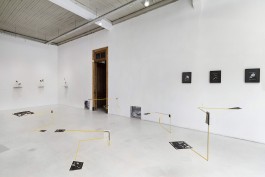
Cut Out Worlds, An Investigation on Photographic Infrastructures, 2019
Die Ecke, Santiago de Chile

Geoportait N 48° 84‘ 54. 469‘‘ E 2° 33‘ 68. 371‘‘, 2019

Geoportait N 48° 89‘ 02. 138‘‘ E 2° 37‘ 03. 281‘‘ and Geoportait N 48° 89‘ 04. 882‘‘ E 2° 36‘ 93. 702‘‘, 2019
smartphone screenshots, black oil paint

March of Progress, We Still Stand With Both Feet on The Ground, 2019
2 prints on velvet fabric, 50 x 50 cm

People as Patterns, 2019, found black and white studio portraits, oil paint, metal bars, motors, 70 x 50 x 40 cm


Geoportait N 48° 84‘ 54. 469‘‘ E 2° 33‘ 68. 371‘‘, 2019

People as Patterns, 2019, found black and white studio portraits, oil paint, metal bars, motors, 70 x 50 x 40 cm

Cut Out Worlds,
An Investigation on Photographic Infrastructures
"Taking pictures first of all means cutting, cutting - out, dividing the visible. Every glance through the viewfinder, every action of the trigger is inevitably an ax blow that separates one part of reality and excludes, rejects and hides the surrounding." Philippe Dubois, 1983
The title of Lilly Lulay’s first solo exhibition at Die Ecke Santiago "Cut Out Worlds, An Investigation on Photographic Infrastructures" refers to this quote. In fact, her works show us what photography in the first place is: a visual cut-out. A rectangular fragment of reality that can travel through time and space. Using the term "Infrastructure" to talk about photography, Lilly Lulay highlights the fact that this journey of an image is linked to its material foundations. Our private analog photographs often stay in one place for years (in a frame, photo album or shoebox). In opposition to this our digital images are constantly kept in motion: they move in our timelines or in the Instagram accounts of our friends and they must be moved manually from one storage medium to another in order to remain visible in the course of technological advances.
Lilly Lualy’s current researches focus on the "smartphone" as a photographic media which has significantly change the ways images are used and distributed. Lulay realized that our personal smartphone images are not only looked at by people, but even more often they are looked at by algorithms which analyze their content to organize them for us and in order to decide what becomes visible to us and what does not. Something similar happens in the works of Lilly Lulay, where we always see but a cut out part of the whole. All her works in this exhibition show us only extracts of the initial images, fragmentary informations that the artist has processed and selected according to specific criteria.
In the exhibition space we find photographs that have traveled from different contexts and times. There are old fashioned black and white studio portraits, printed on thick carton just as screenshots from Lulay’s own smartphone and computer screens. On both image types Lulay intervenes with black oil paint to obscures and at the same time refocuses the view on particular elements of the images. In a video that combines the artists own photographs of Santiago, but also images from people who have lived in or visited the city, the beholder is taken on a seemingly never ending journey through layers of photographs that portrait the city of Santiago. In this exhibition photographs of strangers, friends and from the artist herself are used as raw material to reflect on our contemporary image culture and on the question how images circulate between people and places - now and before.


Digital Dust NOV2017, 2018


Residue Figures, 2019, Figura 1,2,3
photo fragments, brass bars, black acrylic cut outs, shadow

March of Progress, We Still Stand With Both Feet on The Ground, 2019
2 prints on velvet fabric, 50 x 50 cm

Residue Figures, 2019, Figura 2


Residue Figures, 2019, Figura 1,2,3,4
video still from: Santiago, 2019
moving collage; 11: 25 min video loop


video still from: Santiago, 2019, moving collage; 11: 25 min video loop


video still from: Santiago, 2019
moving collage; 11: 25 min video loop
